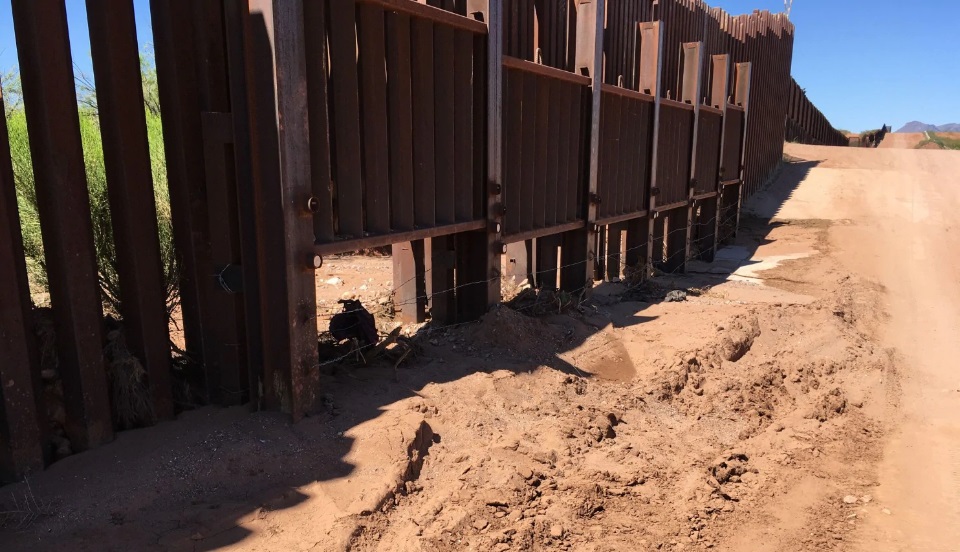President Trump’s border wall likely will require the installation of hundreds of storm gates to prevent flash floods from undermining or knocking it over, gates that must be left open for months every summer during “monsoon season” in the desert, according to U.S. border officials, agents and engineers familiar with the plans.
The open, unmanned gates in remote areas already have allowed for the easy entry of smugglers and migrants into the United States.
At locations along the U.S. southern border where such gates already are in operation, Border Patrol agents must manually raise them every year before the arrival of the summer thunderstorms that convert riverbeds into raging torrents that carry massive amounts of water and debris, including sediment, rocks, tree limbs and vegetation.
Trump’s wall, which features 30-foot metal bollards spaced four inches apart, effectively acts as a sewer grate that traps the debris; when clogged, the barriers cannot withstand the power of the runoff.
Because the gates typically are located in isolated areas that lack electricity, they cannot be operated from afar.
That requires the Border Patrol to leave the gates open for months, increasing the need for U.S. agents to monitor the sites because smugglers and other border-crossers can enter through the large gaps and advance northward following stream channels and narrow canyons to avoid detection.
The flooding risks are one of the biggest engineering challenges to Trump’s vision of a linear man-made structure spanning hundreds of miles of desert, canyons and mountains.
But the Trump administration has said little about how it plans to manage the hydrology of the border region.
Though Trump has boasted that his new “border wall system” will be an impermeable force against illegal crossings and drug trafficking, the need for open gates is another notable weakness that smugglers and migrants can exploit to slip through the barrier and evade capture.
Smugglers have learned how to cut through the new steel bollards using common tools they can buy at hardware stores, and some have demonstrated that the wall can be climbed with handmade ladders and rope.
And most of the hard narcotics that enter the United States via Mexico pass through official border crossings, hidden in vehicles and among cargo, not through the remote areas where Trump’s new barriers are being erected.
Roy Villareal, chief of the Border Patrol’s Tucson sector, which covers most of Arizona, described the addition of the floodgates as an example of how his agency has learned to adjust to the realities of the Southwest’s extreme weather and topography.
“The border is so diverse,” Villareal said. “You have to plan for water flow … People think it’s just this monolithic wall, sort of like the Great Wall of China, where you drop it into place and that’s all there is to it. And that’s not the reality at all.”
Veteran Border Patrol officials acknowledge the government would be foolish to place vertical metal bars in the direct path of rivers and creeks that swell to dangerous volumes during summer storms.
The U.S. southern border is crisscrossed by hundreds of drainage channels and several rivers.
One Arizona river, the Santa Cruz, starts in a United States valley, flows through the mountains into Mexico and returns to cross the border again with more water.
Outside of the high-traffic areas, much of the U.S.-Mexico border through New Mexico and Arizona is lined with vehicle barriers that are welded from old rail tracks.
Though they would stop a car or truck from crossing, they allow water and debris — as well as wildlife and people — to pass through.
Trump’s border project is replacing those barriers with the steel bollards, which act like a sieve and can impede water flow.
At several locations in Arizona where construction crews are racing to erect the structure, workers have been leaving gaps at creek beds and river channels because they do not yet have the new fencing panels with storm gates.
Older vehicle barriers remain in place along those sections, the gaps akin to missing teeth.
The storm gates are different from the much larger vehicle gates the government installs along the Rio Grande in Texas to allow farmers, U.S. agents and others access to land that becomes cut off from the rest of the United States by the barrier.
Those gates can be quickly open and shut and do not need to remain open to manage flooding.
White House officials this month acknowledged they are preparing to divert an additional $7.2 billion from this year’s Defense Department budget for wall construction, money that will allow the administration to complete nearly 900 miles of new barriers by 2022.
If that plan goes forward, it likely will include new barriers in mountainous areas where the force of floodwaters is even greater and engineers would need to install even more storm gates through canyons and creek beds.
